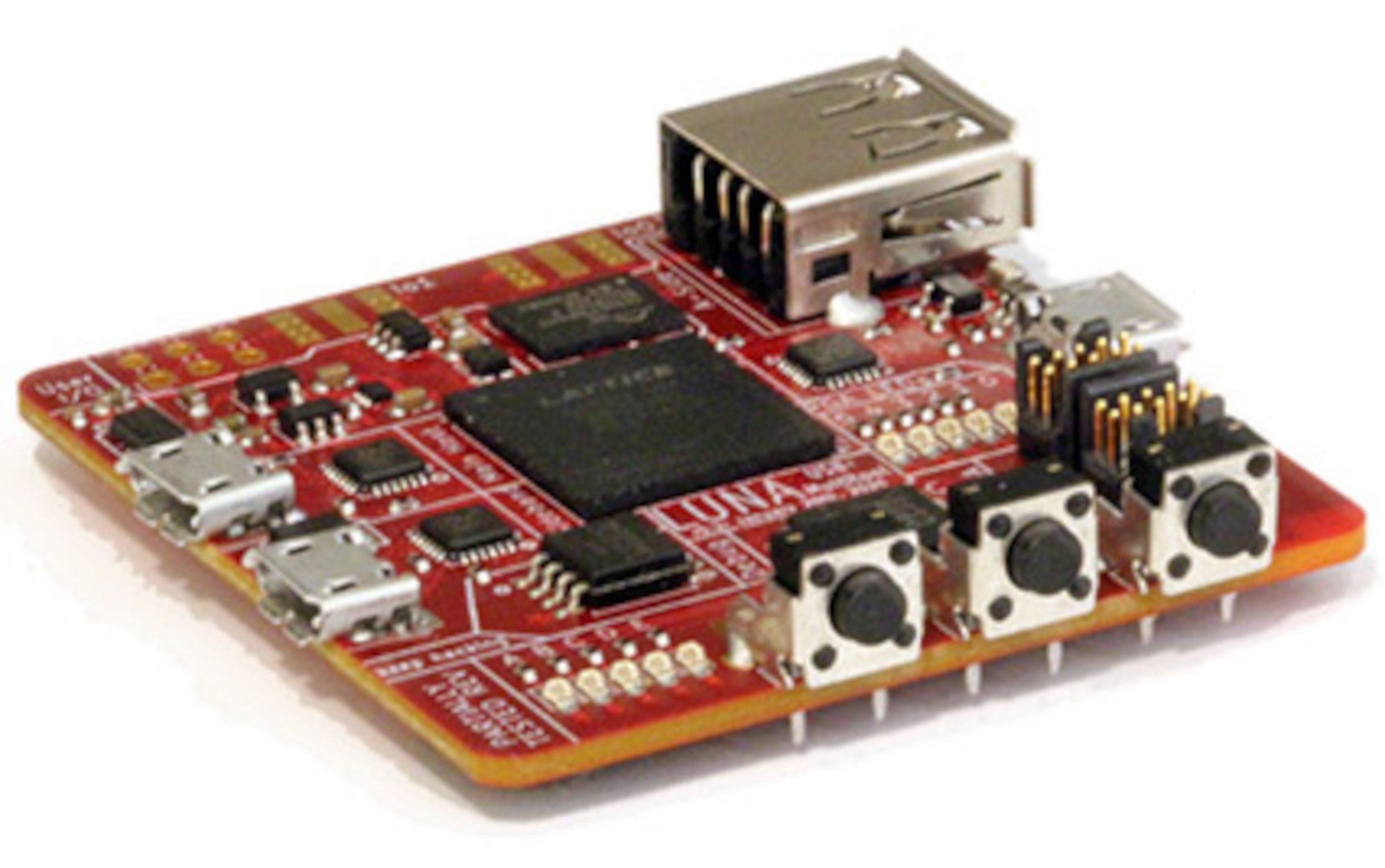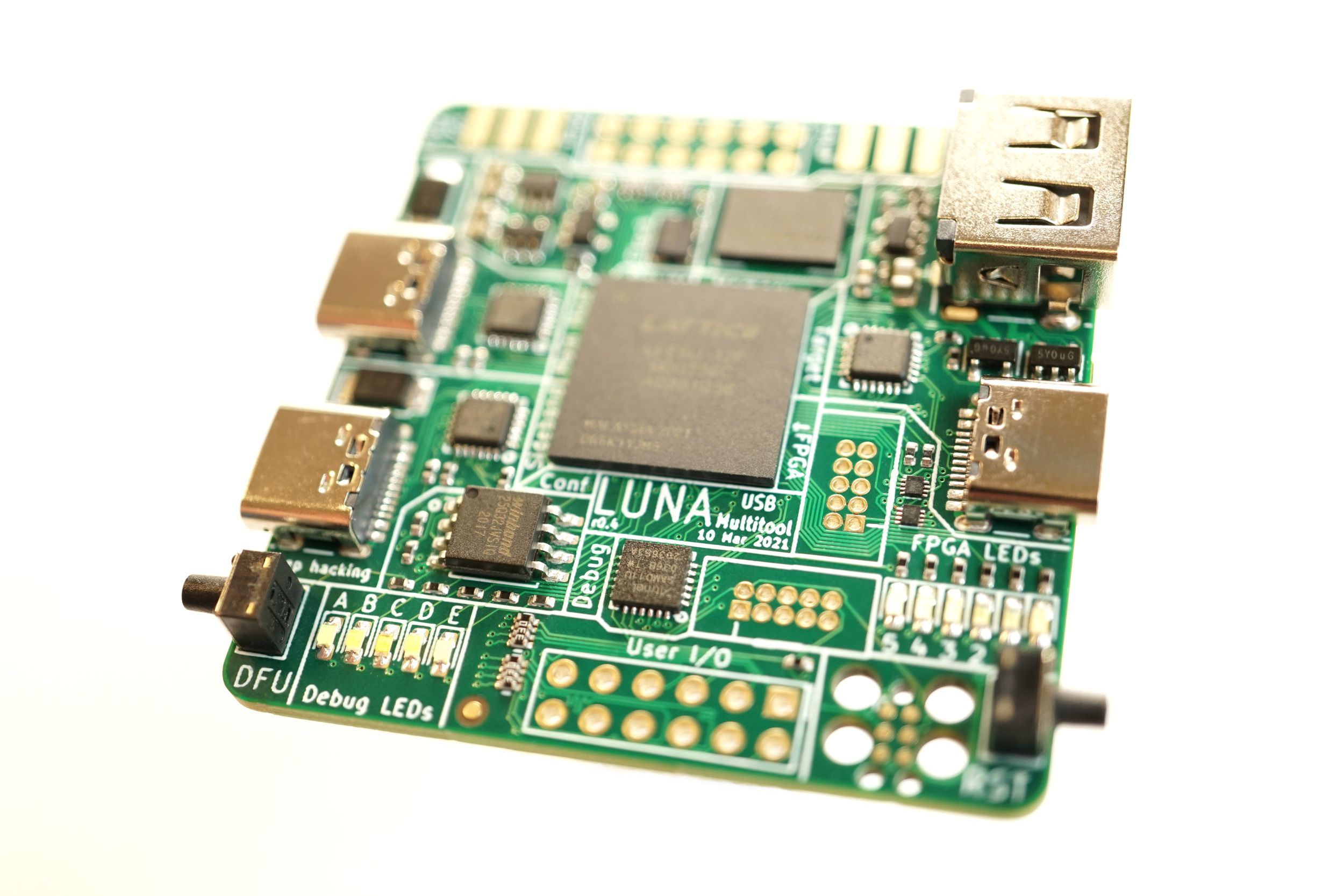Project update 3 of 27
Q&A session on LUNA hardware connectivity
by StraitheHi, friends!
As community manager for Great Scott Gadgets, one of my favourite tasks is finding answers to questions that come in through email, Twitter, GitHub, and Discord. Thankfully you all are great at asking questions, especially about the USB Type-C connectors on LUNA! In this update, Michael Ossmann responds to most of the USB Type-C queries I’ve received (and asked) about LUNA in the last few weeks.
Community Question: Old pictures of LUNA show Micro-USB connectors but the latest pictures show USB Type-C connectors. Why the change?
Kate’s original LUNA design used Micro-USB connectors, but we decided to switch to Type-C connectors a couple of revisions later. Based on the USB specification, Micro connectors may be the best choice for LUNA, but I don’t know anyone who actually likes them. They can be difficult to insert properly and they are less reliable than other USB connectors. Maybe the best thing about them is that the cable that tends to wear out and not the receptacle.
Straithe Question: So other than like-ability, are there other reasons USB Type-C connectors were chosen?
Type-C connectors are more robust and easier to insert than Micro-USB, particularly since they function when inserted in either orientation. They have become quite common, so we think folks are likely to already have cables. Significantly, Type-C is the only connector specified for the recent USB 3.2 and USB4 standards, so we see it as the most future-proof option in regards to cable acquisition.
Straithe Question: Were there any concerns about switching to USB Type-C connectors?
Our biggest concern about switching to Type-C connectors was that it might give a false impression that LUNA supports SuperSpeed USB, often referred to as USB 3.0. We’ve noticed more and more USB 2.0 devices with Type-C connectors over the past couple years, so our hope is that few people would be confused by this.
Type-C connectors also cost more than Micro connectors, which was an important consideration for us since there are three of them on LUNA. One of the ways we have tried to make LUNA accessible is by making it affordable. Fortunately, we were able to find USB 2.0 Type-C connectors that cost less than USB 3.0 Type-C connectors that include SuperSpeed signals.
Community Question: Will LUNA be able to support SuperSpeed with software changes?
No. A Type-C connector can be used on a USB 3.0 device for SuperSpeed, but it can also be used on a USB 2.0 device such as LUNA at Low-speed, Full-speed, or High-speed. Although the LUNA software framework includes some experimental support for SuperSpeed USB on alternative hardware platforms, the LUNA hardware platform is a low-cost device supporting only USB 2.0 speeds.
Straithe Question: You’ve mentioned a number of different USB speeds. To recap, what are the different USB speeds and what USB versions do they line up to?
There are four speeds in the USB 2.0 and USB 3.0 specifications:
| Speed | Data Rate | First Appearance |
|---|---|---|
| Low-speed | 1.5 Mbps | USB 1.0 |
| Full-speed | 12 Mbps | USB 1.0 |
| High-speed | 480 Mbps | USB 2.0 |
| SuperSpeed | 5000 Mbps | USB 3.0 |
(Additionally there are extensions of SuperSpeed in USB 3.1 and above.)
Although the USB 2.0 specification updates previous specifications and includes both Low-speed and Full-speed, a lot of folks refer to High-speed USB as "USB 2.0". Similarly, people often refer to SuperSpeed USB as "USB 3.0", even though it can be found in various versions of the specification higher than 3.0. The USB 3.0 specification supplements USB 2.0, adding SuperSpeed signals on additional wires while following the USB 2.0 specification on other wires within the same cable.
Community Question: Does LUNA come with any cables?
Partly because of our switch to Type-C connectors and partly to save cost and packaging, we have decided not to include cables with LUNA. One of the reasons for this is that it is difficult to predict what cables folks will need for different applications. As an illustration, I used LUNA recently in-line on a connection between a PC and a HackRF One. This required four cables:
- A-to-C cable between the PC and LUNA's Target C port
- A-to-Micro between LUNA's Target A port and the HackRF One
- C-to-C cable between my laptop and LUNA's Host port
- A-to-C cable between my laptop and LUNA's Sideband port for programming
This particular selection of cables depended on the available ports on the laptop, the PC, and the HackRF One. In order to accommodate most of the combinations we anticipate, we would have to include at least half a dozen different cables, making LUNA needlessly expensive and its packaging overly bulky. Instead we decided to keep LUNA small and affordable by relying on LUNA users to acquire their own cables for their individual needs.
Community Question: Does LUNA pass through SuperSpeed signals when used as a USB analyzer?
To use LUNA as a USB analyzer, you use one cable to connect a USB host to LUNA’s "Target" Type-C port and another cable to connect a USB device to LUNA’s "Target" Type-A port. Both of those ports on LUNA are USB 2.0 connectors, so they only pass through the USB 2.0 data signals. LUNA does not pass through SuperSpeed signals or any of the ancillary signals supported on some Type-C devices such as those used for Power Delivery (PD) communication.
Community Question: I guess LUNA doesn’t have any PD capabilities then?
Although we don’t pass Power Delivery signals through LUNA, the hardware is designed to have some ability to transmit and receive PD signals:
| Port | PD Transmit | PD Receive |
|---|---|---|
| Target A | no | no |
| Target C | yes | yes |
| Host | no | yes |
| Sideband | no | yes |
We added these capabilities to the hardware design when switching to Type-C connectors, but we currently do not have a plan to implement gateware for PD. If you have a specific use case for which you would like software support, please let us know. At a minimum it will be possible to implement your own PD solution in nMigen. Note that LUNA’s Type-C ports are not tolerant of voltages above USB’s standard 5 V, so some PD experiments could put your LUNA in danger of overvoltage.
For more sophisticated PD testing and experimentation, including passive monitoring, I recommend checking out Rod Whitby’s USB-PD Add-On for Glasgow currently in development. Rather than adding similar circuitry to LUNA (and making LUNA larger and more expensive), we think this is a great application for a special-purpose design such as Rod’s board.
Community Question: Does LUNA support any USB Alternate Modes?
LUNA’s hardware design also permits 3.3 V I/O on the SBU1/SBU2 signals of all three Type-C connectors. This should enable experimentation with some lower speed Alternate Modes such as those used by some serial debuggers, but it will not support video modes.
Straithe Question: Thank you for answering our questions today. Do you have any last comments?
Thanks for curating these great questions! I just want to give a big thank you to everyone who is supporting LUNA on Crowd Supply. We truly appreciate each and every one of you!





